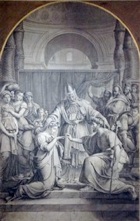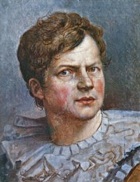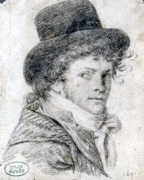
Self-portrait
Palais des Beaux-Arts, Lille
Jean Baptiste Wicar, who was born in Lille, studied painting and design in Paris under Jacques-Louis David. He accompanied David to Italy in 1784, and returned to spend the period 1787-93 in Florence. His fine line drawings of paintings and sculptures in the collection of the Grand Dukes of Tuscany were engraved and published in four volumes in 1789-1807, an endeavour that proved to be both popular and profitable. Wicar befriended Filippo Buonarroti in Florence, and was able to purchase drawings by Buonarrotti’s ancestor, Michelangelo, thereby beginning his renowned career as a collector.
Wicar, who had left-wing sympathies, returned to post-revolutionary France in 1793 and was briefly imprisoned in 1794 after the fall of Maximilien Robespierre. He then returned to Italy, where he spent the rest of his life. He became active in the campaigns of the Emperor Napoleon to requisition art from conquered nations for the Musée Centrale des Arts: Napoleon had established this gallery in what had been the Palais du Louvre in 1793 to house art from the French royal collection and from the collections of aristocrats who had been executed or who had fled abroad. Wicar’s work, which began in the Austrian Netherlands in 1794, continued in Italy after the signing of the Treaty of Tolentino (1797), which marked the start of the systematic expropriation of the finest Italian art.
Wicar left Florence for Rome in 1799, leaving behind part of his impressive collection of drawing by famous Italian artist that was subsequently stolen. He became a member of the Accademia di San Luca in 1803. His most important commission at this time was the panel (1804) of Pope Pius VII Ratifying the Concordat in the papal retreat at Castel Gandolfo, which drew heavily on his skills as a portraitist.
Wicar became a member of the Accademia di San Luca in Rome in 1805. Joseph Bonaparte, King of Naples appointed him as the director of its equivalent in Naples, the Reali Scuole di Belle Arti, in 1806-9. Here, he enjoyed the strong support of Antonio Canova, who was (ironically) central to the efforts to repatriate Italian art from France after the fall of Napoleon in 1814. Wicar remained the most important artist at the court Naples after the accession of Joachim (Gioacchino) Murat and his wife, Napoleon’s sister Caroline (1808-15).
Wicar continued to build up his collection of drawings by Renaissance artists, concentrating towards the end of his life on those by Raphael. He bequeathed many of these to his native city, and the collection is now in the Palais des Beaux-Arts, Lille.
Foligno
Baptism of Christ (1826-35)
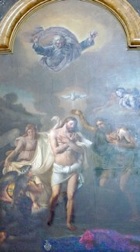
There is a preparatory sketch in oil for this work in the Collection of the Fondazione Cassa di Risparmio di Perugia (below).
Perugia
Wicar formed a close friendship with Fabrizio della Penna of Perugia, and often stayed at Palazzo della Penna. He encouraged Fabrizio to build up the family's already outstanding art collection. Wicar also formed a close friendship with Filippo degli Oddi (see below).
The Perugian Giuseppe Carattoli became a student of Wicar in Rome, and was nominated as his executor. Works that Wicar bequeathed to him joined his collection, which subsequently passed to his son, Luigi Carattoli. He donated it to the Accademia di Belle Arti in 1894, and it is now displayed in the Galleria Nazionale (see below).
Preparatory Sketch (ca. 1803)
This sketch in oil, which is signed by Jean Baptiste Wicar, depicts Roman charity (a story told by ancient Roman authors in which Xanthippe fed her father Mycon with her own milk when his gaolers forbade him food). The associated final panel was apparently submitted by Wicar to the Accademia di San Luca in 1803 to support his application for membership. It has since disappeared. The sketch, which was still in Wicar’s studio in Rome when he died in 1834, passed into a private collection and entered the Collection of the Fondazione Cassa di Risparmio di Perugia in 2003.
Marriage of the Virgin (1825)
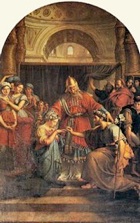
The altarpiece, which was painted in Rome, was criticised in some quarters, probably because of the resentment aroused by the part that Wicar had played a part in the Napoleonic confiscations of 1797 , which had included Perugino's original altarpiece from this chapel. Specific criticisms included the fact that the Virgin and St Joseph were depicted kneeling before the Jewish priest. The figure of St Joseph was said to resemble a satyr while the female figures to the left were said to be unduly voluptuous.
A preparatory design for this altarpiece is exhibited in the Museo dell’ Accademia di Belle Arti (below).
Preparatory Sketch (ca. 1826)
This sketch in oil by Jean Baptiste Wicar was made in preparation for his last work, the altarpiece (1826-35) of the Baptism of Christ for the Duomo, Foligno (above). The work was protracted: the sketch and the incomplete panel were still in Wicar’s studio in Rome when he died in 1834. His pupil, Decio Trabalza completed the panel, and it is still in the Duomo. The sketch, which passed into a private collection, in the Collection of the Fondazione Cassa di Risparmio di Perugia.
SS Peter and Paul (1825)
Abbot Vincenzo Bini commissioned this panel from Jean Batiste Wicar for the Cappella del SS Sacramento of San Pietro in 1825, just before he left Perugia to take up his post as Procurator General of the Cassinese Congregation. The panel, which was painted in Rome, was placed on the altar so that part of a venerated fresco of the Madonna del Giglio could be seen through an annular opening between the standing figures of the two saints. The panel has recently been removed.
Works in the Galleria Nazionale
The works by Jean Baptiste Wicar from the Carattoli Collection that are exhibited in the Galleria Nazionale include:
-
✴a compete set of preparatory drawings for his the panel (1804) of Pope Pius VII Ratifying the Concordat, in the papal retreat at Castel Gandolfo, including a fine sketch in oil on canvas of the head of Pius VII;
-
✴a sketch in oil (ca. 1821) for an altarpiece of the Risen Christ with SS James and Antony of Padua; and
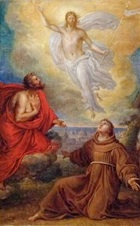
-
✴the so-called Ritratto di Damigella (Portrait of a Bridesmaid), a sketch in oil on canvas (ca. 1809) sometimes said to depict Queen Caroline of Naples. (She was the sister of Napoleon who married Joachim (Gioacchino) Murat, one of her brother’s generals. In 1808, Napoleon appointed them as King and Queen of Naples, positions they held until their deposition in 1815).
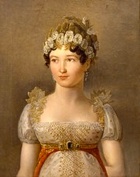
Works in the Accademia di Belle Arti
